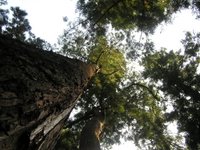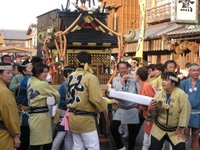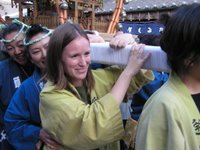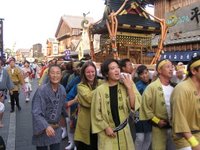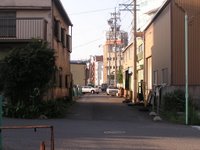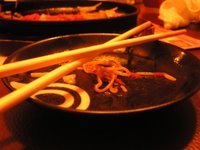Belated Post
Takakura-Jingu
~ or ~
The Case of the Missing Shrine
~ or ~
The Case of the Missing Shrine
Pretty fun day today, despite starting to feel a little sick. (Colds are rough.)
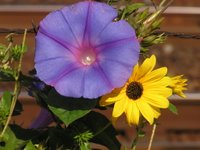 When executed properly, poorly-planned days become grand adventures.
When executed properly, poorly-planned days become grand adventures.After a (really) late (illness-related) start, I went out to find Atsuta-jingu with Iain; we were unsuccessful and it was brilliant. A gorgeous, picture-taking day.
Found Iain as I walked down a side street taking photos of a building which is either an Eastern Orthodox Church or a mosque, though the designs on the side throw some doubt on any monotheistic affiliation. Seems he'd gone in before and found, after a brief tour and gift-giving, that it was not, if fact, Atsuta-jingu. So we took a little walk through southern Kanayama, towards Nishi Takakura.
 Eventually we found something that looked promising; tree tops poking above suburbs are usually one of two things: shrines (or temples) or parks. In our case, it turned out to be the former; and a cool shrine it was.
Eventually we found something that looked promising; tree tops poking above suburbs are usually one of two things: shrines (or temples) or parks. In our case, it turned out to be the former; and a cool shrine it was.Unfortunately I don't have any photos of it, because I was too busy being taken on a personal tour by the monk-on-duty to take any. Iain and I walked into the shrine grounds, washed our hands at the spring, and then were flagged down by the approaching monk. He talked to us in Japanese far too fast for my contextual-Japanese-listening-ability to process, then switched to some basic English. Cool guy. Cool guy, even though he mocked my Japanese ability, my taiko drumming, my lack of golf knowledge, and told me I smelled the wrong end of a broken leaf. Still.
 He seemed a little surprised that an American and a Scotsman were visiting a shrine in the suburbs in Nagoya. We didn't tell him we thought it was Atsuta-jingu. Anyway. He showed us the proper way to wash your hands before entering a shrine: first you dip the wooden ladle in the spring and tip it up to pour the water down the handle, purifying the ladle. Then you dip it in again and pour some water over your left hand, then switch hands and pour the rest of the water over your right hand. Then take another ladleful of water and rinse out your mouth. And finally, take another ladleful of water, tip it back, and pour it over the handle again. Hands and mouth (and ladle) clean, and you're ready to enter the shrine.
He seemed a little surprised that an American and a Scotsman were visiting a shrine in the suburbs in Nagoya. We didn't tell him we thought it was Atsuta-jingu. Anyway. He showed us the proper way to wash your hands before entering a shrine: first you dip the wooden ladle in the spring and tip it up to pour the water down the handle, purifying the ladle. Then you dip it in again and pour some water over your left hand, then switch hands and pour the rest of the water over your right hand. Then take another ladleful of water and rinse out your mouth. And finally, take another ladleful of water, tip it back, and pour it over the handle again. Hands and mouth (and ladle) clean, and you're ready to enter the shrine.So we did, after being handed gifts of hashi (chopsticks), sweets, and tea. In the shrine, the monk asked us if we knew taiko. Well, not personally, but yeah, we've heard of taiko. Taiko, drumming, involves a person - usually a monk or priest - hitting a drum. Very, very hard. Apparently I don't hit it hard enough. "No! Battle! Battle!" Great advice for drumming. A few more demostrations and we were good to go.
Next step was a blessing; which, from what I could gather, went like this: "Oh great Takakura Kiyomi, I humbly ask you to bless this American guy and this...you're Scottish right? this Scottish guy too. Please give them good luck and good health, and help that American guy hit the drum harder next time. And sorry for waking you up; it was their idea."
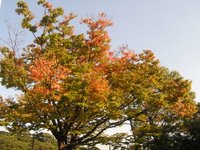 After that we headed out to see a "two hundred and one thousand year"-old tree. He had us lean up against the tree to feel "the old spirit" that was supposed to "refresh your heart". I was missing my apple and book - it would have been perfect. As a gift, another gift I guess, the monk broke off leaves for Iain and I; "Smell" he said, so we did. I was holding the wrong end of the leaf. He growled a "Bah" at me and turned the leaf around so I could smell the broken end, where it had until recently been attached to the tree. It smelled like Life.
After that we headed out to see a "two hundred and one thousand year"-old tree. He had us lean up against the tree to feel "the old spirit" that was supposed to "refresh your heart". I was missing my apple and book - it would have been perfect. As a gift, another gift I guess, the monk broke off leaves for Iain and I; "Smell" he said, so we did. I was holding the wrong end of the leaf. He growled a "Bah" at me and turned the leaf around so I could smell the broken end, where it had until recently been attached to the tree. It smelled like Life.As we were walking back across the courtyard, the monk told us his children were in the U.K. "at the famous golf course in England." Nani? (what?) He yelled to the woman monk manning the souvenir stand something that I can only guess was "Hey ____-san, what's that famous golf course in England; the one near where my kids go to University? These guys want to know." The "famous golf course in England" is St. Andrews, actually in Scotland, actually 45 minutes from Iain's home. His kids went/go to St. Andrews University. "My children English para para." Random.
 Iain and I left amid much bowing and "arigato gozaimasu"s and went to see if we could find the actual Atsuta-jingu. We did manage to find Atsuta Jingu Koen (the Park), which is quite nice and a ten-minute walk from Jo's flat. It's also the home of the Nagoya Congressional Hall (or something like that), which looks like it dropped out of future and landed in a field without disturbing the homeless population too much.
Iain and I left amid much bowing and "arigato gozaimasu"s and went to see if we could find the actual Atsuta-jingu. We did manage to find Atsuta Jingu Koen (the Park), which is quite nice and a ten-minute walk from Jo's flat. It's also the home of the Nagoya Congressional Hall (or something like that), which looks like it dropped out of future and landed in a field without disturbing the homeless population too much. After walking around for a bit, becoming frustrated with our lack of shrine-finding ability and getting rather hungry, we wandered back towards Nishi Takakura. On the way, we found an interesting possibility: the "Sherlock Holmes Beer and Restaurant". Sandwiches and coffee later, we decided to call it a day. Came home, forgetting to book tickets to Sendai, and spent the evening wondering how, exactly, one human head can produce so much snot.
After walking around for a bit, becoming frustrated with our lack of shrine-finding ability and getting rather hungry, we wandered back towards Nishi Takakura. On the way, we found an interesting possibility: the "Sherlock Holmes Beer and Restaurant". Sandwiches and coffee later, we decided to call it a day. Came home, forgetting to book tickets to Sendai, and spent the evening wondering how, exactly, one human head can produce so much snot.Thank goodness for the five million Nova tissues I got from the staff.





